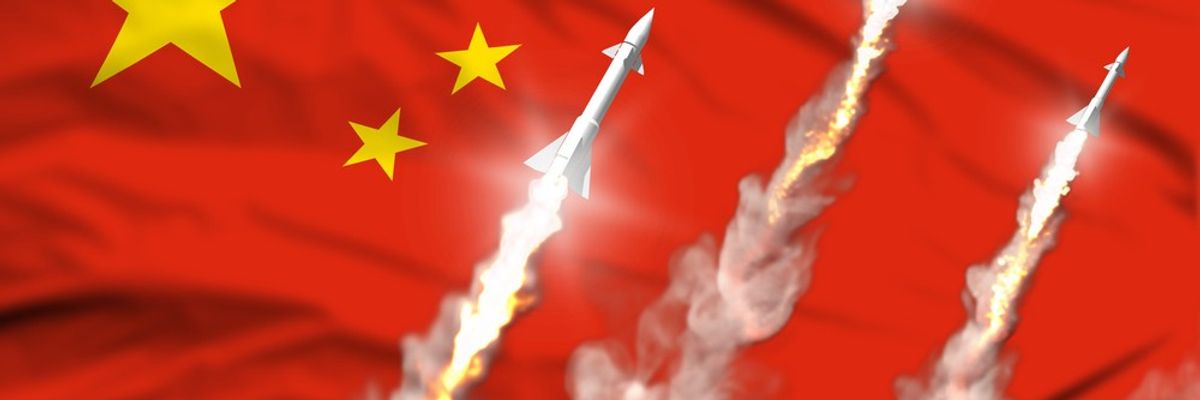Rising fears of a conflict with the U.S. are leading China to increase the size of its strategic nuclear forces, according to new reporting from The Wall Street Journal.
This shift in Chinese threat perception, the Journal reports, is accelerating an effort from Beijing to construct at least 100 new missile silos in Gansu province that could potentially house strategic warheads capable of striking the United States. This acceleration of China’s nuclear buildup has ushered in a broad debate over the risk this expansion poses to the United States.
In April of 2021, for instance, Admiral Charles Richard, head of U.S. Strategic Command, testified before Congress that China’s nuclear weapon modernization efforts, including placing a number of ICBMs on a “launch on warning” posture, “bring into question its ‘No First Use’ policy declaration.” Why else would the Chinese move to increase the readiness of its nuclear deterrent, Admiral Richard’s testimony implied, if they did not possess a greater willingness to use that deterrent offensively?
Significant attention has been paid to China’s efforts to modernize and expand its nuclear deterrent in the last two years. In addition to building new missile silos, Beijing has tested hypersonic weapons and examined the benefits of consistently mating missiles with nuclear warheads. These developments have caused consternation among U.S. officials as they seem to indicate a shift from China’s traditional nuclear policy. Is Adm. Richard right in assuming that an increased nuclear readiness posture inherently indicates a heightened commitment on the part of the Chinese to use their deterrent, including in a possible first strike? Is a Chinese “launch on warning” posture incompatible with its “no first use” pledge?
China’s nuclear deterrent is characterized by three hallmarks, in contrast to its nuclear competitors, the United States and Russia. Historically, China has committed to maintaining a “minimum” nuclear deterrent; eschewing a “launch on warning” posture; and pledging to avoid using its nuclear weapons first (known as “no first use”) in a nuclear exchange. This has lent an innately defensive posture to China’s nuclear arsenal; an explicit effort on the part of China to maintain strategic deterrence and deterrence only.
Since 2019, however, China has embarked on a modernization and expansion of its deterrent capability potentially at odds with this historically defensive character. Of particular concern is that China’s moves to put some, if not most of its nuclear deterrent on a “launch on warning” posture would abrogate its “no first use” pledge as well. For instance, State Department officials have told the The Economist magazine that China has conducted exercises involving the use of a “launch on warning” posture. Similarly, former Chinese officials have questioned, in the wake of the AUKUS deal specifically, whether it is time to abandon China’s commitment to not use nuclear weapons first in an exchange.
It is difficult to determine whether a given state’s “launch on warning” posture is offensive or defensive. It can serve both purposes simultaneously. Conceptually, a “launch on warning” posture should be defensive, as the deterrent is designed to launch on the warning of an incoming attack; i.e., fired in retaliation. However, because the missiles and warheads are mated and therefore ready to fire at any time, there is nothing preventing a state from launching their deterrent whenever they choose to do so. Therein lies Admiral Richards’ apparent concern: If China’s missiles are ready to fire at a moment’s notice, what is preventing them from shooting first?
The answer, for starters, is the disparity in the nuclear balance between the United States and China. Indeed, China has an arsenal of some 320 nuclear warheads compared to the Americans' 5,800. Even the most hawkish analyses conclude that Beijing’s arsenal could only expand to 1,000 nuclear warheads by the end of this decade—a still sizable imbalance between the two countries. It would be catastrophic for the Chinese to fire the totality of their nuclear arsenal preemptively, as they do not possess enough warheads to achieve a successful first strike. China would undoubtedly face retaliation, resulting in the deaths of hundreds of millions of its citizens.
Similarly, Washington’s nuclear triad — the successful dispersion of its strategic deterrent across land-, sea- and air-based warheads — means the U.S. possesses a secure retaliatory capability even if the Chinese achieved parity.
China could indeed abrogate its pledge to not use its weapons first in a nuclear exchange but given the size of its arsenal—now and even in the future—all logic would discourage such a move. Ultimately, the incentives underpinning stability in the U.S.-China nuclear balance remain the same. This is why, at least publicly, China reaffirmed its commitment to “no first use” in October of last year and even called for arms control negotiations.
Why then, is China modernizing its nuclear arsenal as well as potentially increasing its size? As the Journal report indicates, China is seeking to ensure it continues to maintain a credible second-strike capability given the heightened threat environment it faces. China has historically been in possession of 20 operational silos for its ICBM force. While 20 silos may have qualified as a “minimum deterrent” for the past 30 years, Chinese policymakers likely no longer view it as sufficient given an environment in which two successive U.S. administrations have essentially attempted to contain China.
Indeed, sources familiar with Beijing’s leadership state that Chinese leaders have grown increasingly convinced that Washington is “willing to take greater risks to stop China’s rise.” Thus, while the numerical nuclear balance between China and the United States essentially remains the same, the threat environment as perceived by China has shifted dramatically. What was once a secure second-strike capability previously is no longer enough to give Chinese policymakers the same sense of security and reassurance today.














